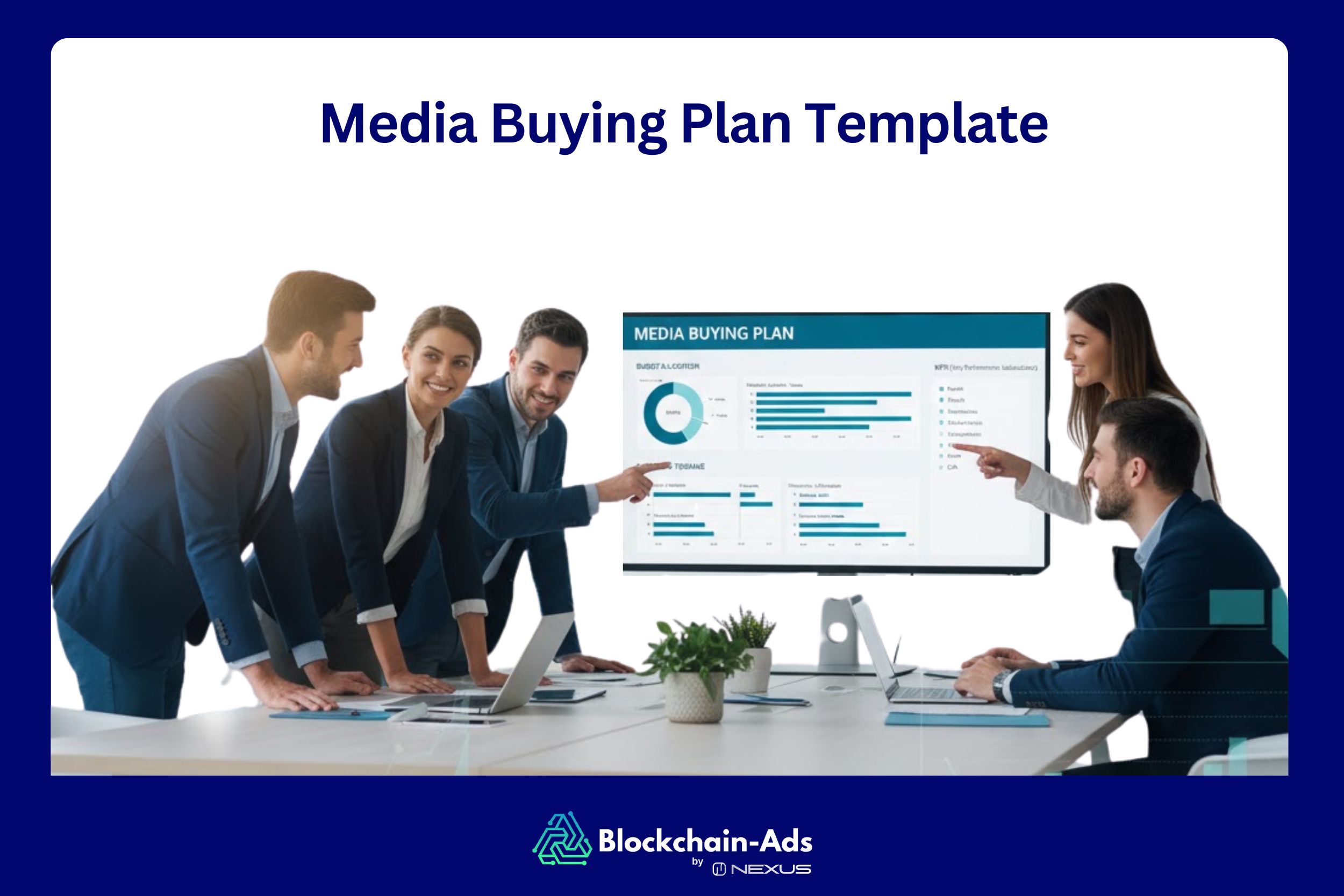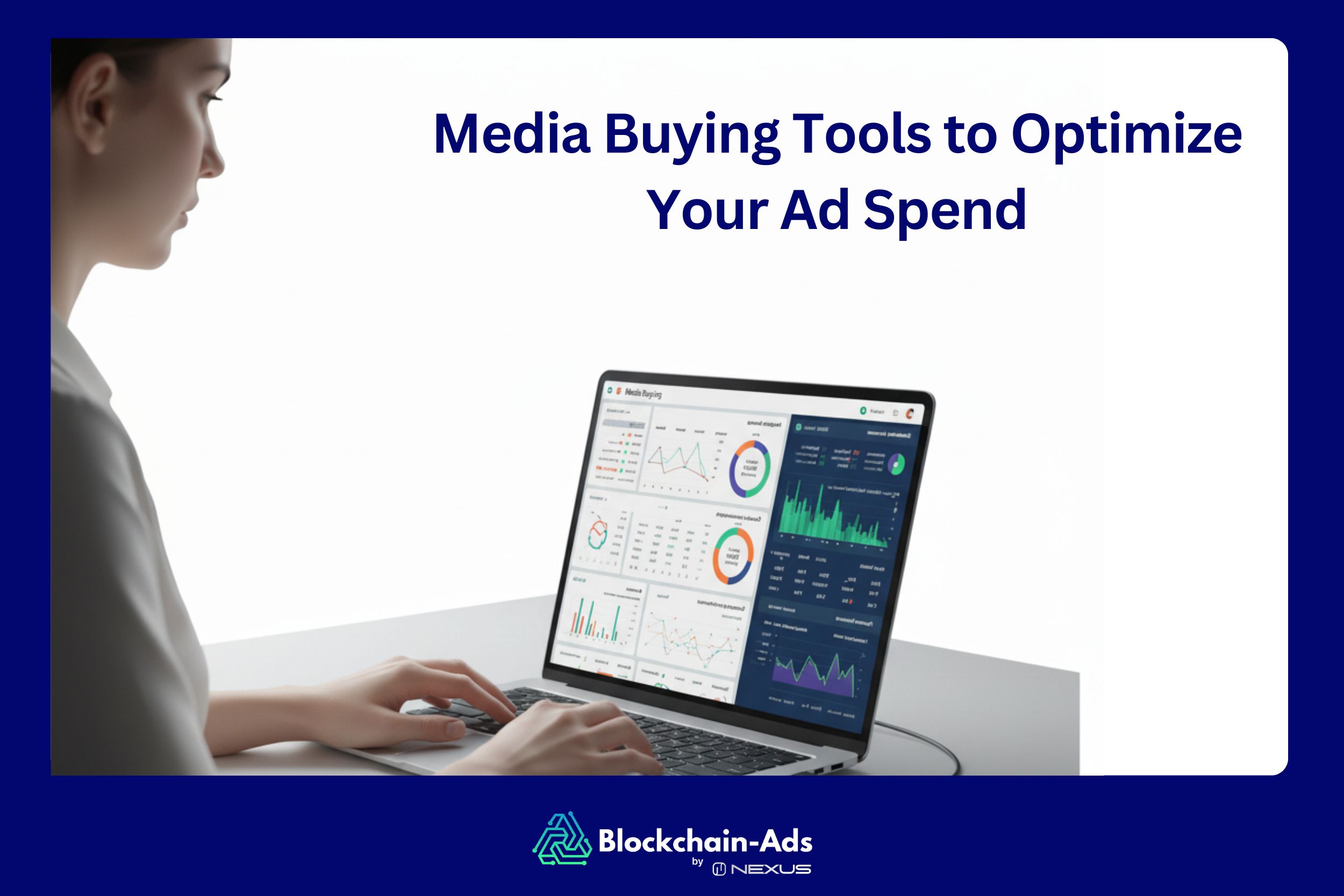Paid Advertising Funnel: How to Attract, Nurture & Convert
A paid advertising funnel turns strangers into loyal customers by guiding them through four stages. It starts with campaigns that build awareness through engaging content, then move to the consideration stage where helpful messages deepen interest and curiosity in your solution. As people grow more interested, the conversation stage kicks in with persuasive messages that encourage them to take action, then follow through with the retention stage to build trust and loyalty.
But how do you build this funnel and track it to make sure it converts and retains customers? To build and track funnels, advertisers define clear stages, set strong goals, choose the best creative strategies, and then measure campaign success using analytics and attribution tools. However, most platforms leave advertisers struggling with data gaps, fragmented reports, and unreliable tracking, making it tough to improve and invest with confidence.
Thankfully, Blockchain-Ads’ DSP solves these challenges with real-time blockchain-verified tracking, precise audience targeting, and transparent analytics. This has given so many advertisers complete control and confidence in every campaign, as seen in these case studies. In this article, advertisers will learn actionable strategies, advanced funnel tools, to help them build funnels that convert.
What Is a Paid Advertising Funnel?
A paid media funnel is used by digital advertisers who want to develop a structured, measurable path that converts leads into active users. It begins with creating exposure among audiences using sponsored content on paid media channels. What follows next centers around convincing potential clients to sign up and complete transactions.
Paid funnels are different from traditional sales funnels in several ways. The most obvious is that traditional funnels rely mostly on word-of-mouth or organic traffic, while paid advertising is driven by paid traffic.
There's also the predictable scalability and intentional targeting possible only with paid advertising. Some of the main benefits of having a structured paid funnel are:
- It reduces customer acquisition costs (CAC) by being more efficient and offering controlled scaling.
- There's a noticeable improvement in ROAS (return on ad spend) when engaging in funnel-based retargeting and segmentation.
- The speed of execution is faster, especially in user acquisition, testing, and optimization cycles.
- Quick funnel adjustments can be made because paid campaigns generate performance data in real time.
- It helps you scale your ad spend effectively by identifying the profitable channels and doubling down on these.
What Are the Key Stages of the Paid Media Funnel?
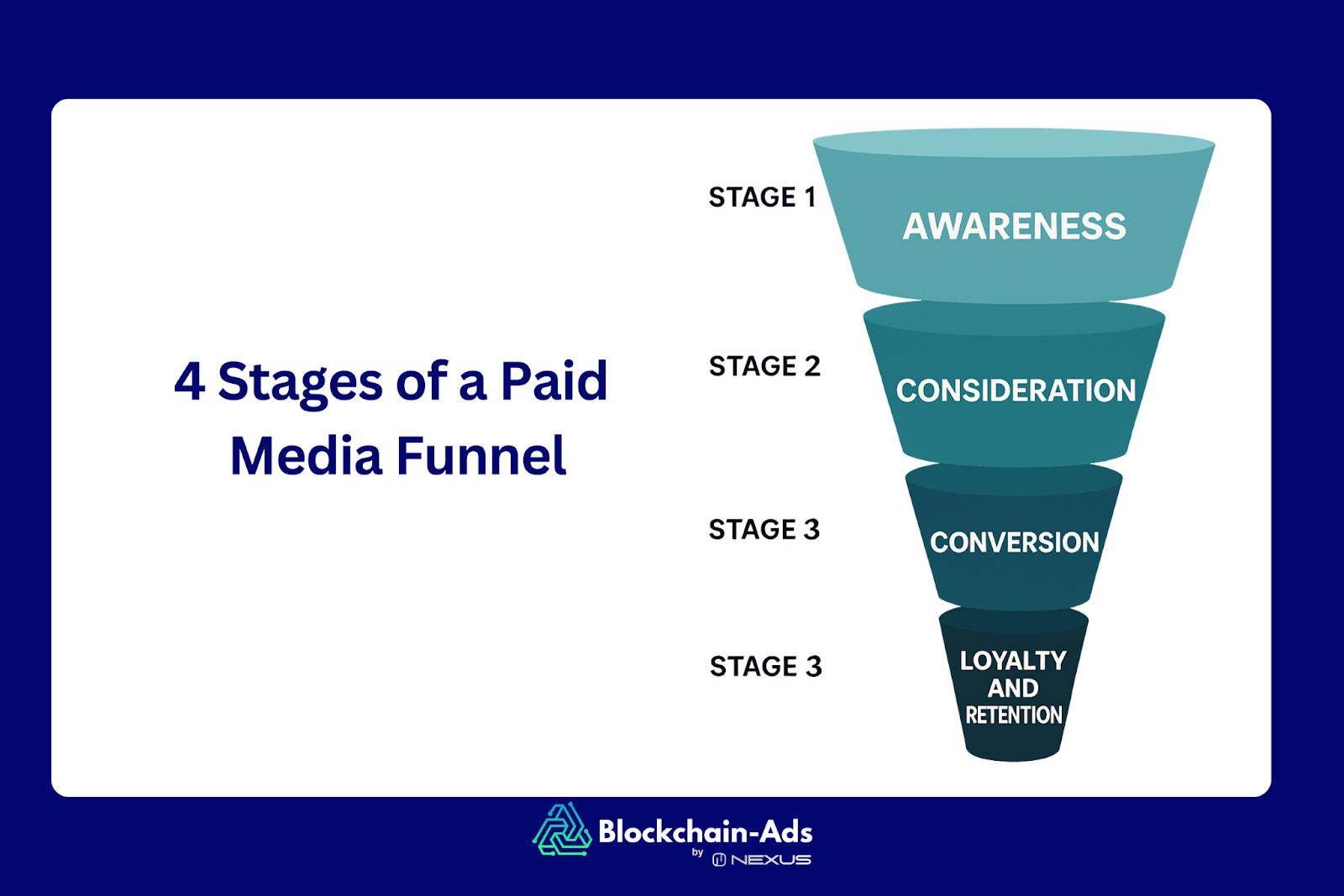
Although there could be more or fewer stages, a paid media funnel is essentially divided into four main stages. These steps map the customer's journey from first contact to when they take the final action:
- Awareness – This is where you generate visibility with ad campaigns to spark user interest.
- Consideration – Here, you build a strong connection with your leads to keep their minds on the product.
- Conversion – Motivate your leads to make a purchase or sign up in this stage of the funnel.
- Loyalty and Retention – Keep customers interested with incentives that will make them loyal to your product.
When executed properly, these funnel stages will improve your chances of success, and here's how:
Awareness (Top of Funnel - TOFU)
In this stage, your goal is to position yourself within the ecosystem of the target audience. Awareness creates opportunity, and since many users are unaware of the product, here's where you put it on their radar.
Some effective ad formats that capture attention quickly are native ads, short social media reels, or YouTube pre-rolls. Users who develop an interest in your ads are the perfect audience for the next stage in the funnel.
Consideration (Middle of Funnel - MOFU)
This is where you launch a targeted campaign to address this particular need of your audience. Potential leads in this stage are aware of what your product is about on the surface. However, they need to know more to make a decision, especially if they have other options.
More detailed ad formats, like search ads that target keywords or banners with product benefits, will work best here. The leads who engage with them become the best candidates for the next stage.
Conversion (Bottom of Funnel - BOFU)
Sealing the deal is the best way to describe what you must achieve in the bottom stage of the funnel. The customers who make it here are no longer in doubt. They know the details of your product and have decided to use, buy, or subscribe to it.
It's necessary to make the onboarding process seamless, as complicated sign-ups or payment systems can lead to user fatigue. You can implement lead-generation tactics using attractive video ads with CTAs or affiliate promotions with registration bonuses to sweeten the process.
Successful conversions at the BOFU stage are your main focus now and should be moved to the next stage.
Loyalty & Retention (Post-Funnel)
What you want to do here is extend the life cycle of users by turning them into repeat customers. These clients have keyed into the product and liked it but will need motivation to stay loyal and possibly introduce it to others.
You can encourage more engagement by developing loyalty programs or creating a social media community that fosters customer interaction. The key is to ensure satisfaction with product deliverables and incentivize clients, who will then fuel the TOFU with referrals.
What Types of Paid Ads Work Best at Each Funnel Stage?
The type and quality of ads at each funnel stage determine how successful your marketing campaign will be. Here's a table comparing paid ad formats, followed by an overview of how each excels:
Native Ads
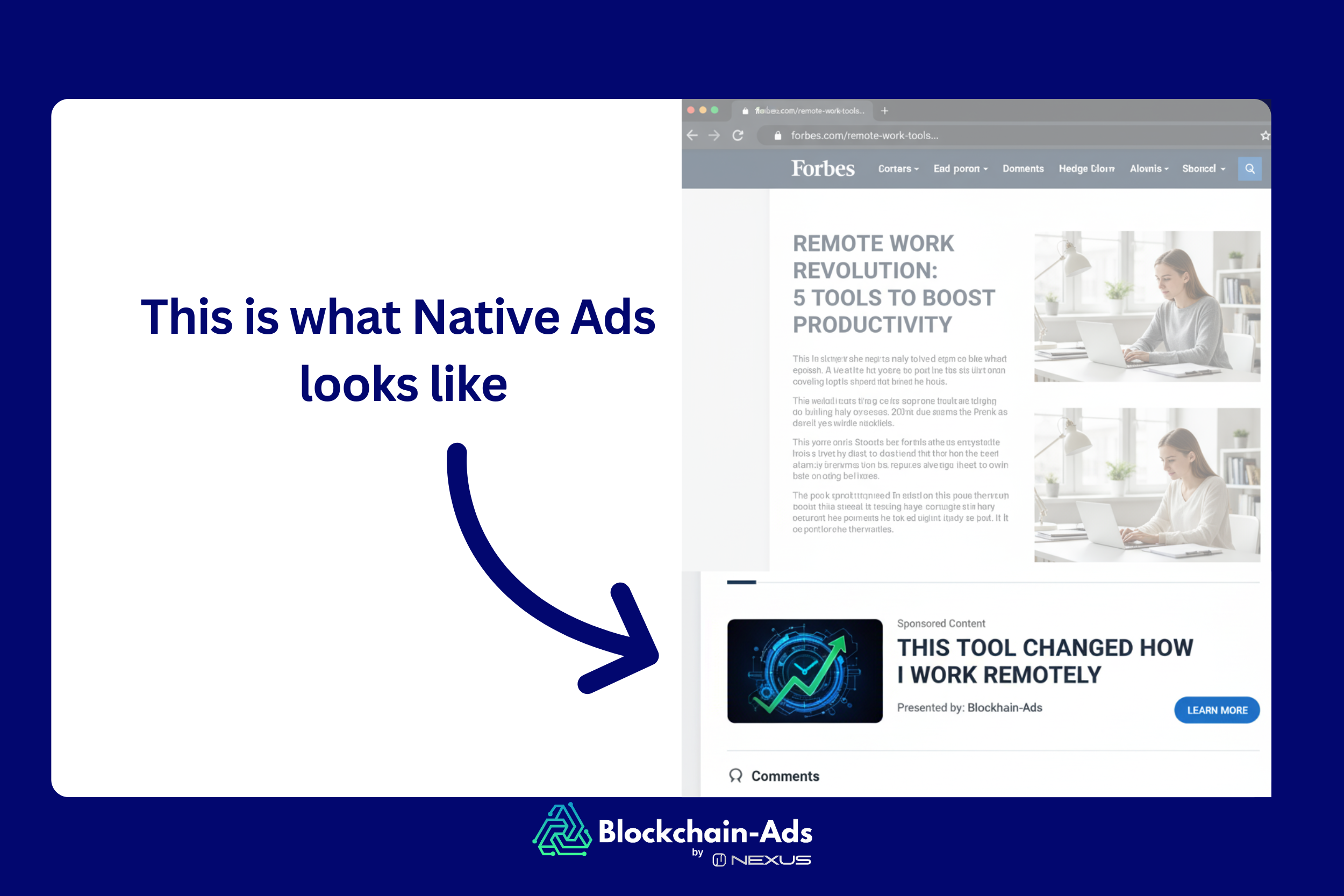
Native ads blend seamlessly with the surrounding page and will have captions that tie in with the content. They're best suited for the TOFU and MOFU stages because of their high CTR and lead engagement. If you want to create awareness, generate leads, and build brands, native ads are best run on platforms like Blockchain-Ads.
Display Ads
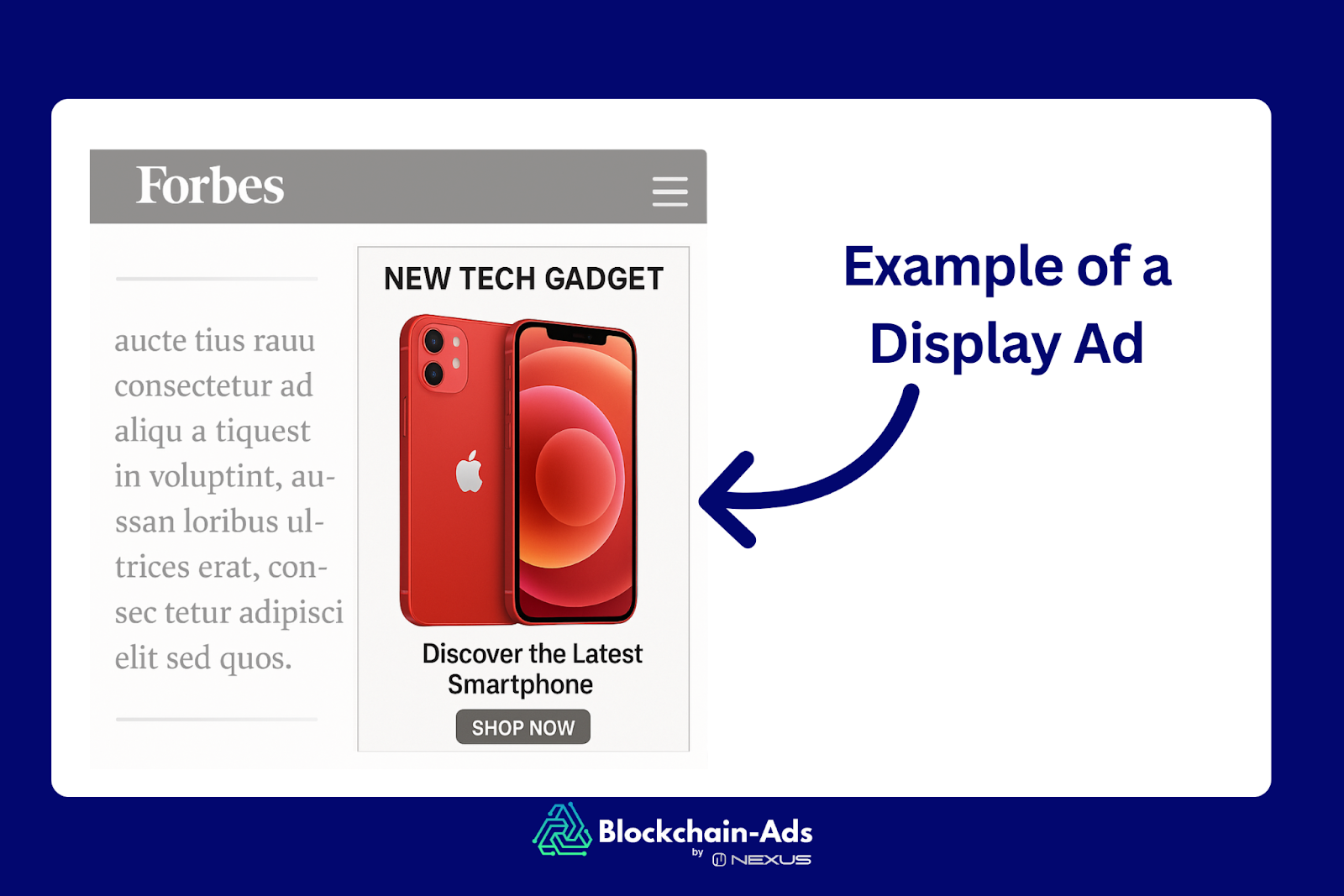
Instead of dispersing your message in the hopes that it resonates with the audience, display advertising targets your potential clients. They can be images, videos, or dynamic text and are most effective in the TOFU or the MOFU/BOFU stages.
Their colorful designs, broad reach, and flexibility make them effective when you want to highlight your brand’s presence. They're good for retargeting, awareness, and brand recall when used on Blockchain-Ads or the Google Display Network.
Video Ads

Video ads work best when you want to tell a story that gets the attention of viewers visually. The duration of the video should be short so it can appear in-stream as a pre-roll or mid-roll on video streaming platforms.
It's best for TOFU and BOFU because the videos are very engaging and impactful. The main objectives of video ads are to create awareness about the product and convert leads. They're most effective on YouTube or social media video feeds. Advertisers can also get precisely targeted video ads placement using Blockchain-Ads.
Search Ads
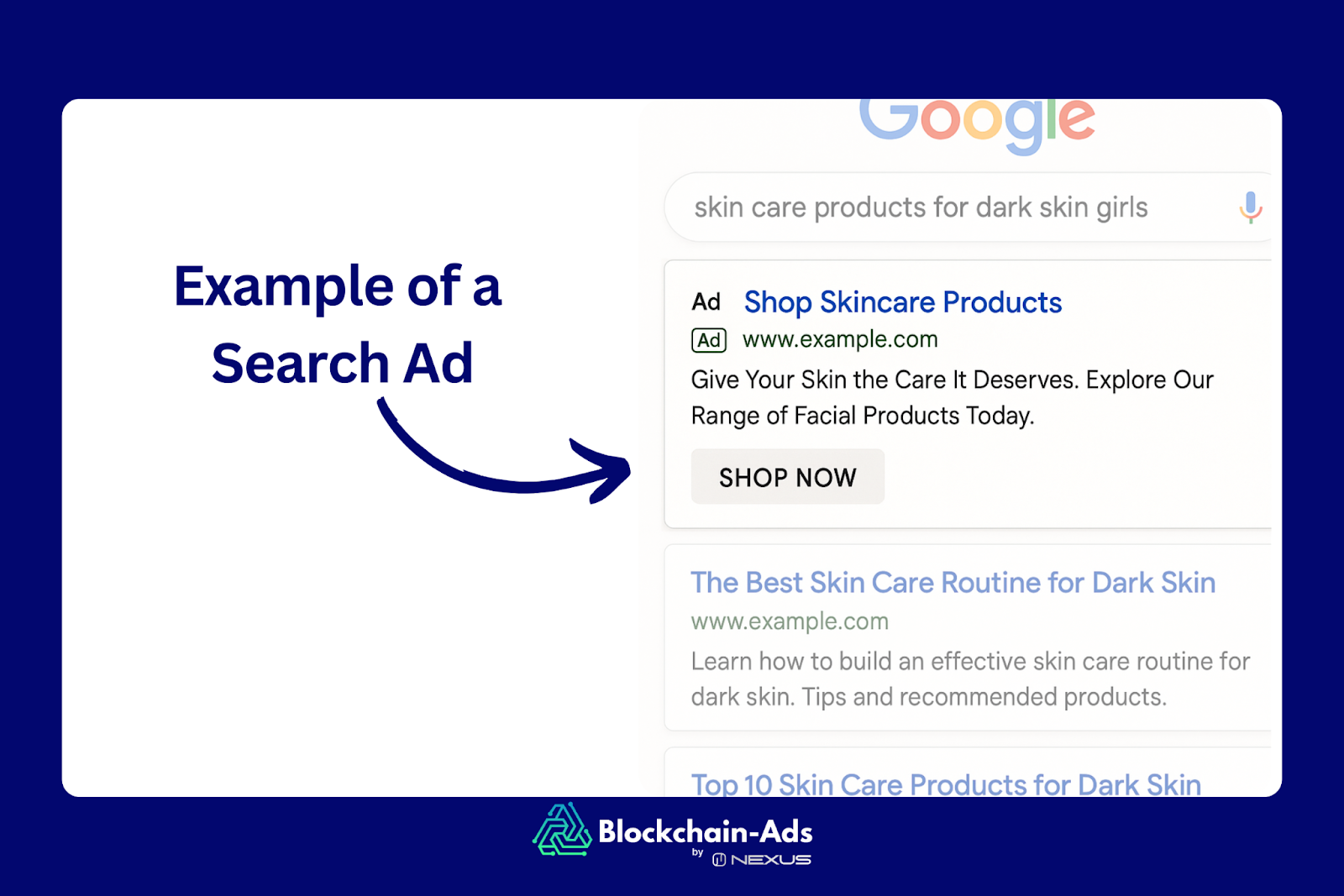
Search advertising is very effective at attracting traffic to your website or product. They target the exact keywords that potential clients may be searching for with appealing headlines. A typical search ad works because it provides a clear and concise message that directly addresses the customer's queries.
The objective is to generate leads and boost conversions, which makes it perfect for the TOFU, MOFU, and BOFU stages. Popular search engines like Google, Yahoo!, and Bing are good platforms for search advertising.
Social Media Ads
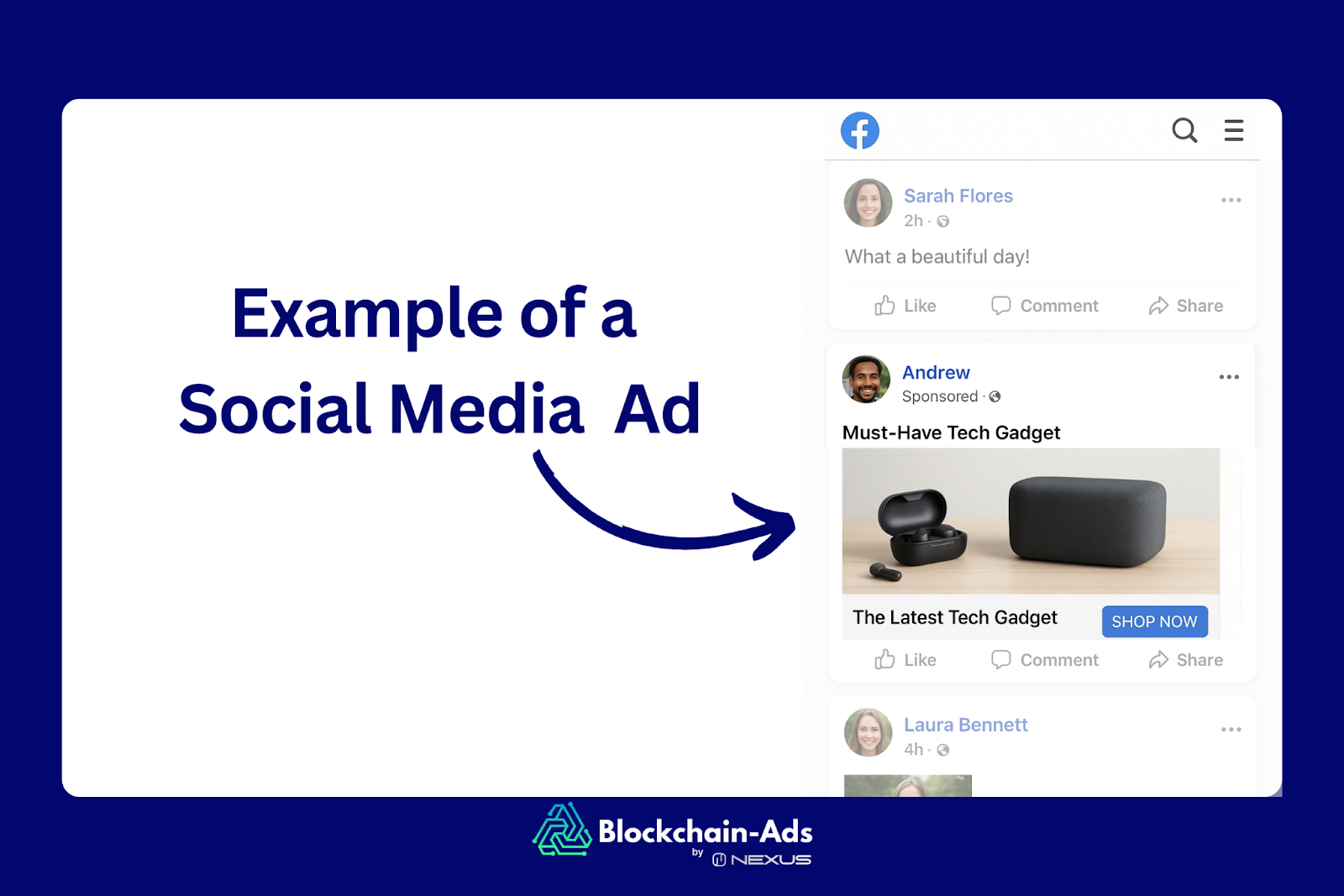
Social media ad placement is an efficient way to get your products into the space of a target audience. The strategy is simple, as it involves creating and sharing content with the community while leveraging influencer partnerships. All three stages (TOFU, MOFU, and BOFU) are good areas for social media advertising.
It works because it disseminates the full message of your campaign and is excellent for social proof via user likes/comments/shares. The main objective of this ad format is to reach audiences, create engagement for retargeting, and lead conversions. Common platforms where these ads can run include Meta, LinkedIn, and X.
In-App Ads

In-app advertising is a great strategy for bringing your products to users who are using an app. These ads are effective because, unlike display/search ads, users can't scroll past without viewing them. They pop up on the app screen and stay on for a few seconds before giving customers the option to purchase or exit.
The effectiveness of in-app ads makes them suitable for the TOFU, MOFU, and post-funnel stages. When using them, your goal should be to retarget old users while creating awareness for newbies. Some platforms that work best for in-app advertising are AdMob and IronSource.
CRM & Email-Based Ads
At its core, CRM (Customer Relationship Management) and email-based advertising are all about the user experience. It's a strategic type of marketing that leverages customer data to create more personalized experiences. The loyalty (post-funnel) stage is where this format shines best, and it works because it makes the user feel important.
The goal of email-based and CRM ads is to retain existing clients, improve community engagement, and encourage reactivations. Some top platforms that stand out for this ad format are HubSpot, Mailchimp, and Zealy.
How to Build a Paid Advertising Funnel
To develop a high-performing paid media funnel, you must invest time and resources into building it. Here's a breakdown of the process from start to finish:
- Define funnel stages based on buyer journey.
- Set goals and KPIs for each stage.
- Choose paid media channels strategically.
- Create funnel-aligned creatives.
- Set up tracking and attribution.
- Launch, measure, and iterate.
Each step represents a core activity that's essential for reaching the right audience at every stage in the funnel.
Step 1: Define Funnel Stages Based on Buyer Journey
Start by segmenting the funnel into meaningful stages that reflect where your potential customers are in their journey. With the right mapping, your ads can be personalized and be more receptive to leads. To get it right, ensure:
- Your ad impressions, clicks, and conversions redirect to the right stages.
- Each audience group should be unique and not overlap across stages.
Step 2: Set Goals and KPIs for Each Stage
Define the specific goals for every stage and set the measurable KPIs. This is important because you can only assess the funnel’s performance and optimize it if you have clear metrics. What you must get right on this step are:
- To ensure the metrics are trackable and tied to proper attribution models.
- To align your goals with the appropriate KPIs.
Step 3: Choose Paid Media Channels Strategically
This is where you select the best media channels that suit your target audience and align with the funnel stage. Choosing the right channel boosts visibility and leads to more conversions. Your focus should be on:
- Audience-driven platforms like Blockchain-Ads provide advanced behavioural and interest based targeting and retargeting across awareness, consideration, conversion, and retention stages.
- Intent-based platforms like Google for awareness.
- Platforms with wide reach, such as YouTube and Meta for awareness, conversions, and retention.
Step 4: Create Funnel-Aligned Creatives
Develop ads (videos, images, or text) that match the purpose of each stage. Doing this correctly improves conversion rates and reduces your ad spend due to ineffective creatives. You can be more successful if you:
- Use attention-grabbing ads for awareness campaigns.
- Create compelling CTAs for better conversion rates.
Step 5: Set Up Tracking and Attribution
Here's where you set up your tracking and UTM parameters and attribution model, which can be linear, first-click, or last-touch. Without this, you can't measure funnel performance or optimize underperforming stages. You'll be more successful on this step by:
- Using specific campaigns in each stage for easier tracking.
- Focusing on one attribution model at a time, such as clicks or form fills.
Step 6: Launch, Measure, and Iterate
Now, you can launch your ad campaigns, analyze the results, and continuously adjust your creatives and placements. Having a feedback loop will help you improve your CAC and ROAS. Getting this stage right involves:
- Reallocating your ad spend toward high-performing stages and ads.
- Running tests on variations of ads and different audiences.
How to Track Funnel Performance by Stage
It's important to track the performance of each funnel stage to identify leaks and where to optimize or make adjustments. With the right tracking methods, you can successfully monitor the following metrics:
- Reach, Impressions, and View Through Rate.
- Click-through Rate, Time Spent, and Engagement Rate.
- Conversion Rate, Cost per Acquisition, and Return on Ad Spend.
- Customer Lifetime Value, Repeat Purchase Rate, and Churn Rate.
Below is a list showing the different tracking methods to use for these metrics:
- Pixel-Based Tracking
- Server-to-Server (S2S) Tracking
- SDK-Based Tracking (for Mobile/In-App)
- UTMs & First-Party Analytics
Pixel-Based Tracking
This involves placing a snippet of JavaScript or a 1x1 pixel on your website to capture actions like page views and purchases. It works best for TOFU, MOFU, and BOFU when implementing web campaigns. Some tools that use this method are Meta Pixel, Google Tag, and Blockchain‑Ads Pixel.
Benefits:
- It integrates well with Google.
- Easy to implement.
- Real-time data collection.
Server-to-Server (S2S) Tracking
With S2S tracking, the data gets sent directly to ad platforms from your server. You can implement this for web or mobile campaigns that focus on reliability in the MOFU and BOFU stages. Meta’s Conversion API, Google Server-Side Tagging, and Taboola S2S are some of the tools that implement S2S tracking.
Benefits:
- Advanced attribution across web and mobile devices.
- Effective against ad blockers.
- High tracking accuracy
SDK-Based Tracking (for Mobile/In-App)
This tracking type is great for in-app ads, as the software libraries can be embedded to track installations and retentions. It's best for in-app purchase campaigns that occur in the TOFU, MOFU, or post-funnel stages. Popular tools that implement this method are AppsFlyer SDK, Adjust, and Branch SDK.
Benefits:
- Effective for real-time optimization.
- Supports LTV tracking.
- Provides granular insights.
UTMs & First-Party Analytics
With this tracking method, you can feed source data into your analytics system by appending the UTM parameters to ad URLs. It works across all stages of the funnel, including the post-funnel segment. The main tools that rely on this are Google Analytics, HubSpot, and Kissmetrics.
Benefits:
- Perfect for retargeting campaigns and deep attribution.
- Grants full control over customer data.
- Do not rely on third-party cookies.
Tools & Platforms to Execute Funnel Campaigns
Successful advertisers need a well-categorized toolkit to execute and scale a paid media funnel. These are the tools and platforms that can be used to create and manage your funnel campaigns:
- Advertising platforms
- Tracking and attribution tools
- CRM and retargeting platforms
- Funnel visualization and planning tools
Advertising Platforms

These platforms power your funnel campaigns by providing advanced targeting that drives users from awareness to conversion. They work across devices and channels and can be tweaked to align with customer behavior at each stage. The main platforms include:
- Blockchain-Ads, which are effective for most industries especially highly regulated industries like crypto, finance, igaming, adult, tech and AI.
- Google Ads & Bing Ads are particularly great for internet-based campaigns that require search and display ad formats.
- Meta Ads (Facebook & Instagram) provide targeted awareness and retargeting opportunities across the TOFU, MOFU, and BOFU stages.
- The Outbrain and Taboola platforms are ideal when you want to educate and engage leads with sponsored ads in the TOFU and MOFU stages.
- Unity Ads and AppLovin focus on mobile placements and in-app campaigns, which makes them great for mobile-friendly audiences.
Tracking & Attribution Tools
Tracking and attribution tools help to assess and measure performance across the funnel while understanding how users interact with ads. Their benefits include reducing wastage and optimizing the campaign by identifying the conversion drivers. Common tools are:
- Blockchain-Ads Analytics provides specific attribution and funnel tracking tailored to crypto ad campaigns.
- Google Analytics 4 helps with tracking and multi-touch attribution that analyzes customer behavior.
- Adjust, AppsFlyer, and Branch are more advanced tools that support in-app tracking with cohort performance insights when using mobile-first funnel strategies.
CRM & Retargeting Platforms
With CRM and retargeting platforms, you can effectively trigger reactivations by users who have previously interacted with the funnel. This is possible by leveraging behavioral insights and data that create personalized messaging across funnel stages. These platforms include:
- Blockchain-Ads Audience Targeting allows you to retarget your website visitors, or past buyers. You can upload your CRM list data and activate them securely across campaigns.
- Meta Custom Audiences allows you to retarget users based on their interactions with Facebook and Instagram assets.
- Google Customer Match helps drive conversions and upsells from known customers by retargeting them on Google properties like Search and Gmail.
Funnel Visualization & Planning Tools
Use these tools to map out the customer journey from TOFU to the post-funnel stage. They're helpful when you need to refine the funnel's performance based on data insights. The best tools that help with this are:
- Funnelytics uses a drag-and-drop interface to visually track and optimize paid media funnels so you can monitor how each stage performs.
- HubSpot integrates directly with automation features that make your funnels more dynamic to changes in customer behavior.
- Oribi simplifies the visualization of your paid advertising funnel by generating performance reports automatically.
Common Mistakes When Running Funnel-Based Paid Ad Campaigns
The success of a funnel-based paid ad depends entirely on how well you're able to avoid certain errors. Here's a list of the most common mistakes that can impact your funnel performance:
- Using the same creatives across funnel stages
- Ignoring the MOFU stage
- Having no clear conversion tracking
- Underutilizing CRM and Retargeting Data
- Poor budget distribution across the funnel
It's essential to avoid these issues before running your paid funnel-based ads, and here’s how to fix them if encountered:
Using the Same Creatives Across Funnel Stages
A one-size-fits-all approach won't cut it because users have different interests and preferences. You can fix this by customizing ads to fit each stage of the funnel.
Ignoring the MOFU (Middle of Funnel)
Focusing on TOFU campaigns will leave leads feeling lost if you don't have a plan for the MOFU stage. Correct this by developing MOFU strategies, like product descriptions, that guide users toward making decisions.
No Clear Conversion Tracking
If you're not using a conversion tracking tool, it means you're running blind and can't scale up or make changes. Implement proper tracking of key conversion metrics and measure them against your KPIs.
Under-utilizing CRM and Retargeting Data
Customers who have warmed up to your products might start to lose interest without proper follow-ups. Use your CRM and retargeting tools to re-engage them with personalized campaigns.
Poor Budget Distribution Across the Funnel
Each funnel stage has an important role to play and should have the right budget to avoid losing this. You can rectify this by allocating your budget strategically and adjusting later based on performance.
获得资格并获得访问权限 区块链广告
Lorem ipsum color sit amet sit amet,consectetur
快速定义

与我们目前的一些合作伙伴交谈
查看所有成功案例

达到 12M+
在 10,000 多个网站和 37 个区块链上吸引了 Web3 用户。






.png)

.png)

.png)
